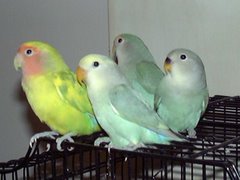Significant Diseases in Lovebirds
As a lovebird's owner, you should know about the most frequent conditions seen in your pet bird. An introduction to pet psittacine diseases with regard to keeping lovebirds as pets will be discussed in this post. In addition to this, some typical symptoms noticed in the lovebird's disease are also highlighted.
Gout
It is a metabolic disorder characterized by deposition of urates and uric acid crystals in visceral organs or tissues. Articular gout is regarded as chronic form. Visceral gout is regarded as acute form. Signs are not specific in visceral gout but in articular gout a typical tophi with whitish yellow centers can be seen around the joints, ligaments and tendons.
Malaria
It is a parasitic disease caused by plasmodium sp. Affected birds reveal absence of normal behavioral activities, anemic signs, edema of eyelids and emaciation. It is a significant to mention that sudden death is commonly encountered in affected bird.
Coccidiosis
It is also a parasitic condition. Red tinged diarrhea is common in affected birds. Weight loss associated with chronic diarrhea may suggest the disease of many birds is housed together.
Egg Drop Syndrome
Usually seen in unmated birds. Any debilitating condition-weather infections, metabolic, nutritional-especially hypocalcemia could cause egg retention. Since a bird producing eggs require increased calories, provisions of good quality diet in adequate is must in them.
Ranikhet Disease
Affected birds reveal yellowish or hemorrhagic diarrhea, coughing, sneezing, and Dyspnea (difficult in breathing). Since Central Nervous System is commonly affected, incordination / hyper-excitability is noticed in addition of jerking of head, torticollis, tremors, nodding, and bilateral paralysis of limbs.
Feather Loss
Hypothyroidism and hyperadrenalism are often associated. Hypothyroidism in pet pittacines is associated with excess fat deposition over legs and abdomen. Affected birds have delayed moult and diffused loss of contour feather and hypercholesteremia along with hypoalbuminaemia will be seen.
Gout
It is a metabolic disorder characterized by deposition of urates and uric acid crystals in visceral organs or tissues. Articular gout is regarded as chronic form. Visceral gout is regarded as acute form. Signs are not specific in visceral gout but in articular gout a typical tophi with whitish yellow centers can be seen around the joints, ligaments and tendons.
Malaria
It is a parasitic disease caused by plasmodium sp. Affected birds reveal absence of normal behavioral activities, anemic signs, edema of eyelids and emaciation. It is a significant to mention that sudden death is commonly encountered in affected bird.
Coccidiosis
It is also a parasitic condition. Red tinged diarrhea is common in affected birds. Weight loss associated with chronic diarrhea may suggest the disease of many birds is housed together.
Egg Drop Syndrome
Usually seen in unmated birds. Any debilitating condition-weather infections, metabolic, nutritional-especially hypocalcemia could cause egg retention. Since a bird producing eggs require increased calories, provisions of good quality diet in adequate is must in them.
Ranikhet Disease
Affected birds reveal yellowish or hemorrhagic diarrhea, coughing, sneezing, and Dyspnea (difficult in breathing). Since Central Nervous System is commonly affected, incordination / hyper-excitability is noticed in addition of jerking of head, torticollis, tremors, nodding, and bilateral paralysis of limbs.
Feather Loss
Hypothyroidism and hyperadrenalism are often associated. Hypothyroidism in pet pittacines is associated with excess fat deposition over legs and abdomen. Affected birds have delayed moult and diffused loss of contour feather and hypercholesteremia along with hypoalbuminaemia will be seen.







 Free Ads For Bloggers
Free Ads For Bloggers


No comments:
Post a Comment